Similarity
Curvature Evaluation
Computational Topology
Skeletal Structures
Meshing/Remeshing
Computer Aided Design
Past Research
|
|
|
|
Graph Comparison
A skeletal
structure is a one-dimensional
representation, which encodes the
decomposition of a shape into relevant
parts that may have either a geometric or
an application-dependent meaning. The
shape comparison approach based on a graph
matching technique allows a structured
process for identifying matched areas on
the input objects so that the matching
results are intuitive and visually
meaningful.
|
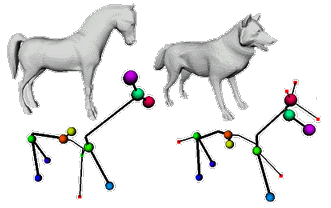
|
|
View
list of related publications
|
|
|
|
|
|
Polygon Morphing
The first step
in polygon morphing consists in
automatically finding on the source and
target polygons couples of corresponding
vertices to guide the blend. We tried to
solve this problem through a morphological
characterization of the shape. An
approximated skeleton is suggested for
coding the shape as a graph of meaningful
areas, and the correspondence problem is
therefore reduced to a skeleton matching
process. The correspondences are found
taking into account the global structure
of the shapes and also local similarity
criteria are used to further refine the
matching.
|
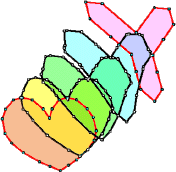
|
|
View
list of related publications
|
|
|
|
|
|
Tailor
Shape analysis
and coding are challenging problems in
Computer Vision and Graphics. To
characterize a shape we have used the
paradigm of Blowing Bubbles: a set of
spheres of increasing radius is drawn,
whose centers are at each vertex of the
mesh, and whose radius represent the scale
at which the shape is analyzed. The number
of connected components of the
intersection curve between each bubble and
the mesh gives a first qualitative
characterization of the shape in a 3D
neighborhood of each vertex. Then
geometric properties, such as an
approximated curvature estimation, are
used to refine the classification and
detect specific features like sharp
protrusions or wells, mounts or dips,
blends or branching parts.
|
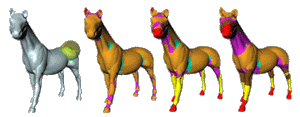
|
|
View
list of related publications
|
|
|
|
|
|
Plumber
The Plumber
algorithm is finalized at the
identification of tubular features of 3D
objects represented by triangular meshes.
Plumber is developed on the basis of the
multiscale morphological characterization
produced by "Tailor". For each tubular
part found at a given scale, its
approximated axis and cross sections are
determined. The final goal is to segment a
3D model into main bodies and tubular
parts and to encode the tube/body
connectivity and the spatial arrangement
of the tube attachments onto the body.
|
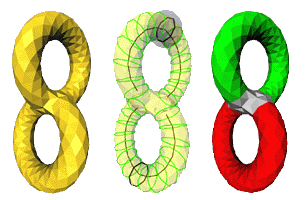
|
|
View
list of related publications
|
|
|
|
|
|
Reeb Graphs
The main
features of a shape and their
configuration are important to devise a
surface understanding mechanism that
discards irrelevant details without
loosing the overall surface structure. Our
approach is based on the classical Morse
theory and would seem to be suitable for
analysing any data that can be modelled as
a surface. Through the analysis of the
evolution of the contour levels of a
surface, we obtain a discrete description
which effectively represents the shape.
Such a description can be encoded into a
topological graph, called a Reeb graph. In
particular, the notion of Extended Reeb
Graph (ERG), we have introduced, is based
on a characterisation strategy that
recognizes critical points and areas by
evaluating the behaviour of the contour
levels on a shape, including also the
so-called degenerate configurations.
Finally, we have proposed an algorithm for
the construction of the ERG extraction
both for terrain models and 3D closed
surfaces.
|
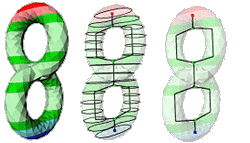

|
|
View
list of related publications
|
|
|
|
|
|
Apparent Contours
An important
visibility feature of a smooth object with
respect to a direction is its outline (or
profile or contour generator), that is the
curve on the surface that separates front
face regions from the back ones. This
curve is correlated both to the view
direction and the object embedding;
furthermore, it may reflect some of the
shape properties.
Instead, the apparent contour of a shape
is the projection of the outline onto a
plane perpendicular to the view direction.
By their properties, apparent contours
have been extensively studied in computer
vision and computer graphics; in
particular, they are used for
non-photo-realistic and silhouette
rendering, camera motion estimation and
partial reconstruction of surfaces.
Moreover, it has been demonstrated that
the knowledge of the apparent contour and
its singularities is enough for estimating
the genus of the surface.
Currently our research efforts are in the
direction of adapting to discrete context
some theoretical results and studying the
evolution of the apparent contour of a
shape when the view direction changes with
time.
|
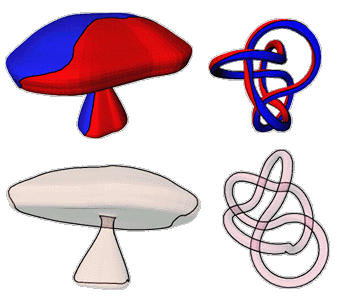
|
|
View
list of related publications
|
|
|
|
|
|
Dual Meshes
This research
focus on duality considering basic
relationships between a 2-manifold
triangle mesh M and its dual
representation M'. The achieved
combinatorial properties define a discrete
homeomorphism between M and M', and the
"dual Laplacian smoothing" which combines
the application to the dual mesh M' of
well-known smoothing algorithms with an
inverse transformation for reconstructing
the regularized triangle mesh. The use of
M' instead of M exploits a topological
mask different from the 1-neighborhood
one, related to Laplacian-based
algorithms, guaranteeing good results and
optimizing storage and computational
requirements.
|

|
|
View
list of related publications
|
|
|
|
|
|
Medial Axis
An intuitive
definition of the skeleton in the
continuum was given by Blum in 1967, who
described the skeleton by analogy with a
fire front which starts at the boundary of
the shape and propagates isotropically
towards the interior. The medial axis is
defined by the locations at which the fire
fronts collide. The medial axis, together
with the radius function, i.e. the
distance from each point on the axis to
the nearest point on the boundary, define
the medial axis transformation (MAT). The
power of this representation is that the
shape's boundary and its MAT are
equivalent and one can be computed from
the other, therefore a two-dimensional
object is effectively transformed into a
one-dimensional graph-like structure. We
have investigated the MAT properties and
drawbacks, and developed an approximated
MAT for planar shapes for use in matching
for polygon blending and surface
reconstruction.
|
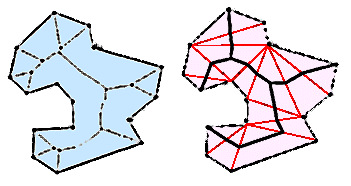
|
|
View
list of related publications
|
|
|
|
|
|
Curvature-based
Skeleton
The Multiscale
Curvature Evaluation proposed exploited in
Tailor, also paved the way to the
extraction of a skeletal structure of a
triangle mesh starting from high-curvature
regions of its surface. Since a high
curvature region is usually located at the
end of a protrusion, the achieved skeleton
strictly reseambles the object shape and,
beeing curvature an intrinsic
characteristic of the surface, the
skeleton is indeed an affine-invariant
representation of the object.
|
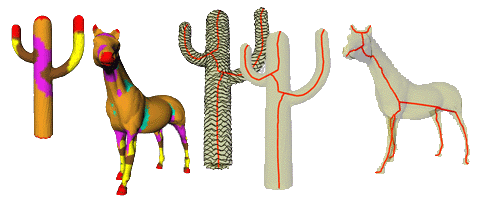
|
|
View
list of related publications
|
|
|
|
|
|
Compression
Here we focus
on the lossy compression of manifold
triangle meshes. Our approach, called
SwingWrapper, performs a retiling of the
mesh to be compressed. In the retiled
mesh, all the triangles are isosceles and
the locations of the vertices are
compactly encoded with our new prediction
technique, which uses a single correction
parameter per vertex. SwingWrapper strives
to reach a user-defined output file size
rather than to guarantee a given error
bound. This makes it particularly useful
when transmitting meshes over networks
with time and band constraints.
|
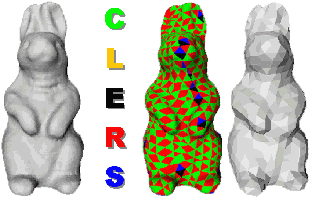
|
|
View
list of related publications
|
|
|
|
|
|
Reconstruction
This research
tackles the problem of creating a triangle
mesh out of a data source, which may be in
the form of an unorganized point cloud,
but also a parametric definition of a
manifold. Our contribution in the surface
reconstruction context is a sculpturing
algorithm which is able to produce
boundary representations of solids with
through holes. When approximating
parametric surfaces, we show how to design
a tessellation primitive that is
independent of the particular mapping used
to describe the surface. Moreover, we show
how to create both isotropic and
anisotropic meshes through our
triangulation approach endowed with a
remeshing strategy.
|
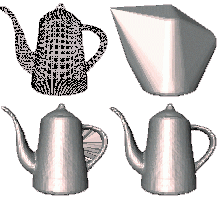
|
|
View
list of related publications
|
|
|
|
|
|
Sharp Feature
Enhancement
This research
studies the 3D "aliasing" of triangle
meshes obtained by feature-insensitive
samplings. Our contribution is a new
Edge-Sharpener filter which identifies the
aliased regions and performs a local
refinement. Information in the
neighborhood is used to sharpen the alised
regions, so that the processed mesh better
reflects the sharp features of the
original model. Experiments shown that the
distortion introduced by the SwingWrapper
remeshing-based compressor can be reduced
down to a fifth by executing
Edge-Sharpener after decompression, with
no additional information.
|
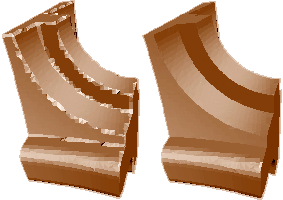
|
|
View
list of related publications
|
|
|
|
|
|
Feature Line
Extraction
Given an
object digitized as sequences of scan
lines, we propose an approach to the
extraction of feature lines and object
segmentation based on a multi-resolution
representation and analysis of the scan
data. First, the scan lines are
represented using a multi-resolution model
which provides a flexible and useful
reorganization of the data for
simplification purposes and especially for
the classification of points according to
their level of detail, or scale. Then,
scan lines are analyzed from a geometrical
point of view in order to decompose each
profile into basic patterns which identify
2D features of the profile. Merging the
scale and geometric classification, 3D
feature lines of the digitized object are
reconstructed tracking patterns of similar
shape across profiles. Finally, a
segmentation is achieved which gives a
form-feature oriented view of the
digitized data. The proposed approach
provides a computationally light solution
to the simplification of large models and
to the segmentation of object digitized as
sequences of scan lines, but it can be
applied to a wider range of digitized
data.
|
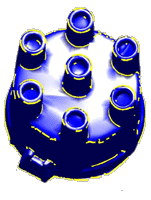
|
|
View
list of related publications
|
|
|
|
|
|
FreeForm Modelling
Free-form
modelling is investigated with respect to
some CAD application fields, from the
traditional mechanical engineering one to
the aesthetic design. In particular, the
research focuses on the extension of the
feature-concept to the free-form domain,
where the freedom of the possible defined
shapes and alternatives makes hard to
define a proper classification and the
insertion of a feature consists in a
deformation of the surface. Whereas in the
mechanical domain few numerical parameters
are sufficient to instantiate a specific
feature element; in free-form modelling
parameters must be higher geometric level
entities (e.g. curves) in order to allow
for the feature shape specification. A
taxonomy of free-form features in the
aesthetic design has been proposed and
prototypes are under development. The
feature-based approach is a high semantic
level methodology which is independent of
the underlying geometry. Together with an
application to the de-facto standard
representation by NURBS, the subdivision
surface technique is also explored as an
alternative. When NURBS surfaces are
adopted to represent the geometry, the
deformation process defined by the feature
curvilinear parameters has been obtained
through a mechanical model based on the
Density Force Method. In case of
subdivision surface, an algorithm to
perform generalised sweep operations
(Sweep-like Features), lead by a profile
section propagating along a directrix, has
been implemented.
|
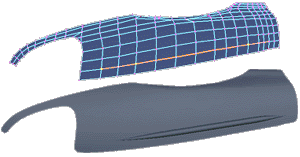
|
|
View
list of related publications
|
|
|
|
|